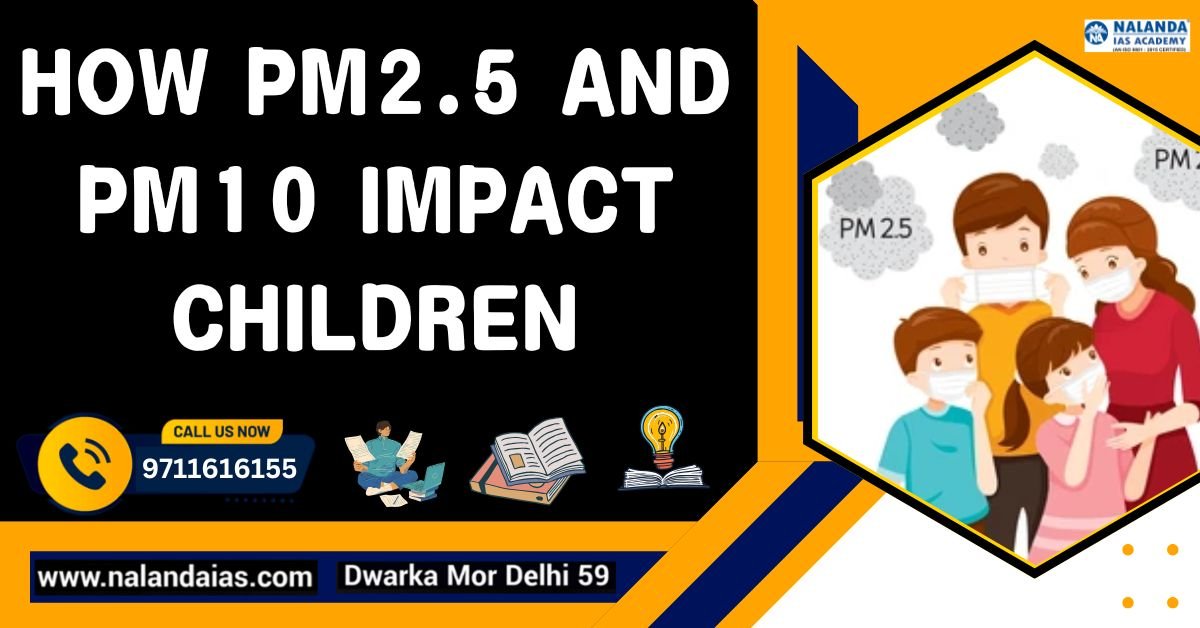How PM2.5 and PM10 Impact Children
How PM2.5 and PM10 Impact Children: Causes, Effects, and Prevention
Why PM2.5 and PM10 Affect Children More than Adults

Children’s Vulnerability to Air Pollution
- Developing Lungs and Immune Systems: Children’s lungs and immune systems are still developing, making them highly susceptible to pollutants.
- Higher Breathing Rates: Children breathe faster and inhale more air per kg of body weight than adults, leading to greater exposure.
- Proximity to Ground Level: Pollutants like PM2.5 and PM10 are concentrated closer to the ground, where children are more exposed.
Health Impacts of PM2.5 and PM10 on Children
Short-term Effects:
- Inflammation and irritation in airways.
- Symptoms: Coughing, wheezing, breathlessness, stinging eyes, and chest tightness.
- Increased susceptibility to respiratory infections.
Long-term Effects:
- Reduced lung capacity: Studies indicate a potential 10-15% reduction in lung capacity.
- Development of chronic conditions like asthma and COPD in adulthood.
- Altered immune responses and structural changes in airways.
- Risk of smaller lung development for children exposed to high PM2.5 levels during growth stages.
Impact on Pregnant Women and Foetuses
- Prenatal exposure to air pollution may lead to:
- Low birth weight.
- Premature births.
- Developmental complications.
Recommendations for Pregnant Women:
- Minimize outdoor exposure during high pollution periods.
- Use N95 masks and air purifiers indoors.
- Maintain a diet rich in antioxidants to combat oxidative stress.
Preventive Measures for Children
Limiting Outdoor Exposure:
- Restrict outdoor activities during peak pollution hours (early mornings and evenings).
- Use air quality apps to monitor AQI and plan activities.
- Opt for indoor play areas with air purifiers.
Using Air Purifiers:
- Equip homes with HEPA filter air purifiers to reduce indoor pollution.
- Regularly clean air conditioning systems and change filters monthly.
Dietary Interventions:
- Include antioxidant-rich foods: Spinach, carrots, citrus fruits, and Omega-3 fatty acids.
- Ensure children drink 1-1.5 liters of water daily to stay hydrated.
Post-Outdoor Hygiene:
- Wash hands and face, change clothes, and perform nasal irrigation after outdoor activities.
Promoting Green Spaces:
- Develop green balconies or garden areas, as plants like spider plants and snake plants act as natural air filters.
Additional Precautions for Children with Pre-existing Conditions
- Establish a healthcare plan with a pediatrician.
- Regular monitoring of lung function through spirometry.
- Maintain detailed records of symptoms and responses to treatment.
- Opt for telemedicine consultations during severe pollution days.
- Prenatal exposure to air pollution may lead to:
Air Pollution and Children
PM2.5 Health Effects
Child Health Protection
Air Quality Management
How to Reduce Indoor Pollution at Home
Impact of AQI on Public Health
Long-term Effects of Air Pollution on Lungs
Air Purifiers: Choosing the Right One for Your Home
Asthma Management in Polluted Cities
Role of Green Spaces in Pollution Control
MCQs on PM2.5 and PM10 Impact on Children (Important for UPSC and others Exam )
1. Which of the following statements regarding PM2.5 and PM10 is correct?
- PM2.5 refers to particulate matter with a diameter of 2.5 micrometers or less.
- PM10 includes all particulate matter with a diameter of up to 10 micrometers.
- Both PM2.5 and PM10 can penetrate the bloodstream through the alveolar barrier.
Select the correct answer using the codes given below:
(a) 1 only
(b) 1 and 2 only
(c) 2 and 3 only
(d) 1, 2, and 3
Answer: (d)
2. Why are children more vulnerable to air pollution compared to adults?
(a) They spend more time outdoors.
(b) Their lungs and immune systems are still developing.
(c) They have a higher breathing rate per kg of body weight.
(d) Both (b) and (c)
Answer: (d)
3. Which of the following health conditions is NOT associated with PM2.5 and PM10 exposure in children?
(a) Asthma
(b) Chronic Obstructive Pulmonary Disease (COPD) in adulthood
(c) Anemia
(d) Decreased lung function growth
Answer: (c)
4. Which of the following are effective strategies to minimize the impact of air pollution on children?
- Use of air purifiers with HEPA filters indoors.
- Consuming an antioxidant-rich diet.
- Restricting outdoor activities during high AQI periods.
Select the correct answer using the codes given below:
(a) 1 and 2 only
(b) 2 and 3 only
(c) 1 and 3 only
(d) 1, 2, and 3
Answer: (d)
5. What role do green spaces play in mitigating air pollution’s effects on children?
(a) They act as a barrier to outdoor pollutants.
(b) They serve as natural air filters by absorbing particulate matter.
(c) They ensure children breathe less polluted air when indoors.
(d) Both (a) and (b)
Answer: (d)
Mains Questions on PM2.5 and PM10 Impact
1. Discuss the reasons why children are more vulnerable to the health effects of PM2.5 and PM10 compared to adults. Suggest measures to mitigate these impacts in urban areas.
2. “Air pollution is a silent threat to children’s health and development.” Critically analyze the statement in the context of the long-term impact of PM2.5 and PM10 on children’s respiratory systems.
3. Examine the role of dietary and lifestyle interventions in minimizing the adverse effects of air pollution on children. How can these measures be effectively implemented in schools?
4. Evaluate the effectiveness of urban planning measures, such as the development of green spaces and traffic regulation, in reducing exposure to PM2.5 and PM10 in children.
5. Prenatal exposure to air pollution has significant implications for foetal and maternal health. Highlight the potential risks and suggest policy measures to address these challenges in highly polluted regions.


